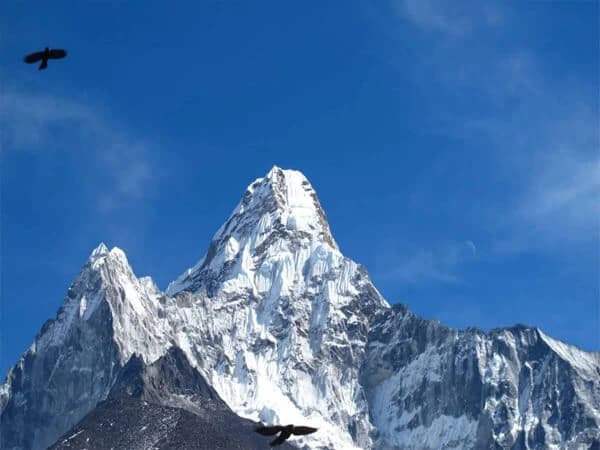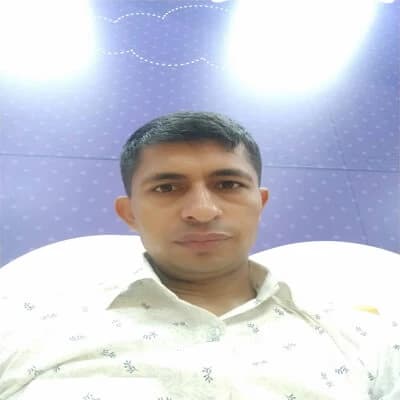Walking up in the Himalayas, where every breath feels lighter and every step puts you closer to the sky, has a profoundly sobering effect. With each elevation gain, the scenery changes, ranging from verdant woods and rhododendron valleys to freezing glaciers and craggy Mountain peaks. The impact of thin air on the human body, however, is a true challenge that every trekker must respect behind this stunning beauty.
High-altitude trekking requires patience, knowledge, and an understanding of how your body responds to a decline in oxygen levels. It also requires strength and endurance. Even the healthiest among us can suffer from altitude sickness, a subtle danger that many adventurers overlook. It is simply the body's normal reaction to change and is not an indication of weakness.
The purpose of this blog is to assist trekkers in being well-prepared, identifying early signs, and avoiding altitude sickness before it becomes hazardous. Knowing how to adjust to the heights can make your adventure trekking in Nepal safer and much more pleasant, whether your desire is to visit Gokyo Lakes, the Annapurna Circuit, or Everest Base Camp. The Himalayas will always push you to the limit, but if you know what to expect, they will also provide you with one of the most amazing experiences of your life.
What is Altitude Sickness?
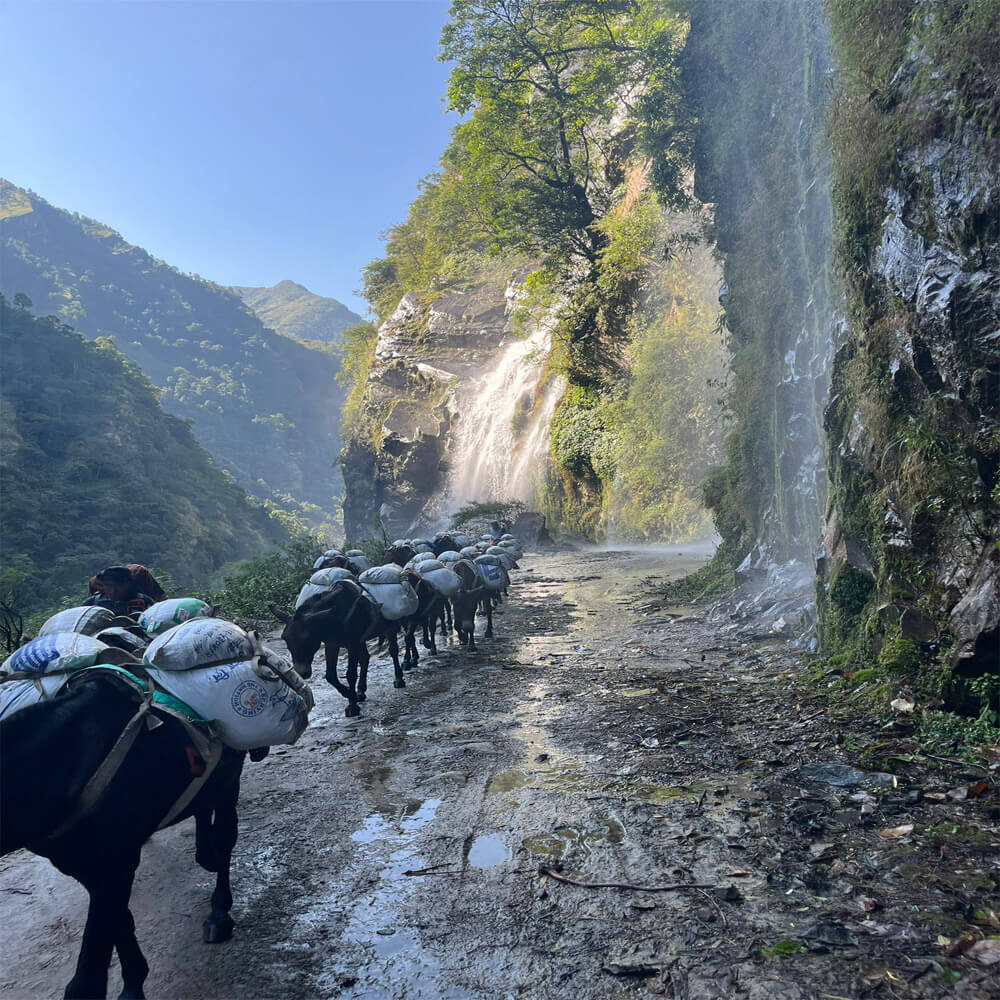
Altitude sickness often called Acute Mountain Sickness (AMS) is one of the most common challenges trekkers face while exploring the high Himalayas. It is the body's normal response to the lower oxygen levels that occur as altitude rises. The air gets thinner and there is less oxygen available for breathing as you ascend higher. If your body does not have enough time to adjust, this change might result in a number of painful and occasionally deadly symptoms.
Knowing about altitude sickness is crucial when trekking in Nepal, whether you are going to the Everest Base Camp, the Annapurna Circuit, or the Langtang Valley. Even the strongest and most seasoned trekkers may experience its effects; it does not discriminate. The most important things are how fast you climb and how well you pay attention to your body.
What Happens to the Body at High Altitude?
The air pressure is high enough for your lungs to readily absorb oxygen at sea level, where the oxygen concentration is about 21%. However, the air pressure decreases over 2,500 meters (8,200 feet), which makes it more difficult for oxygen to enter your blood. Your body must work harder to compensate for this oxygen shortage, or hypoxia, particularly while engaging in strenuous tasks like trekking uphill.
Symptoms such as headache, weariness, nausea, and dizziness arise when your body is unable to adapt quickly enough. Your breathing may become deeper and faster as the heart beats more quickly to pump more oxygen. Even when they are at rest, certain trekkers say they feel as though they are out of breath all the time.
Types of Altitude Sickness
You should be aware of the following three primary categories of altitude-related illnesses:
Acute Mountain Sickness (AMS)
- The most prevalent and mildest type is this one.
- Headache, nausea, exhaustion, lightheadedness, and appetite loss are among the symptoms.
- AMS typically begins 6–24 hours after reaching a higher altitude.
- Rest, hydration, and appropriate acclimatization can all help manage it.
High Altitude Pulmonary Edema (HAPE)
- A buildup of fluid in the lungs is the cause of this more dangerous ailment.
- Chest tightness, coughing, blue lips or fingernails, and shortness of breath even when at rest are some of the symptoms.
- If left untreated, HAPE can be fatal. The best course of action is to get medical assistance right away.
High Altitude Cerebral Edema (HACE)
- Due to brain enlargement, this is the most severe and lethal type of altitude sickness.
- Severe headaches, disorientation, poor coordination, and even unconsciousness are some of the symptoms.
- HACE necessitates immediate medical intervention and a drop in altitude.
No matter their age, level of fitness, or prior Nepal trekking experience, anyone can get altitude sickness. The bodies of some people just adjust more slowly than those of others. The secret is to pay great attention to your body and not undervalue the altitude.
It is possible to avoid altitude sickness. You may safely visit high-altitude locations like Everest Base Camp, Annapurna Circuit, or Langtang Valley and genuinely experience the Himalayas worry-free if you are prepared, acclimated, and alert.
Who Is at Risk?
Anyone trekking above 2,500 meters can experience altitude sickness, regardless of age or fitness level. However, certain factors increase the risk:
• Climbing too fast without proper acclimatization.
• Dehydration due to not drinking enough fluids.
• Overexertion — pushing your body too hard early in the trek.
• History of altitude illness from past treks.
• Lack of rest days in your itinerary.
Even strong athletes are not immune because acclimatization is not about strength it’s about giving your body time to adjust.
It is possible to avoid altitude sickness. You may safely visit high-altitude locations like Everest Base Camp, Annapurna Circuit, or Langtang Valley and genuinely experience the Himalayas worry-free if you are prepared, acclimated, and alert.
Why It’s Important to Understand Altitude Sickness
It is important to respect altitude sickness rather than to be afraid of it. You can trek with confidence and safety if you understand how it operates. For this reason, many Himalayan treks include acclimatization days in their itinerary. Before going higher, these respite days let your body naturally acclimate to the lower oxygen levels.
Additionally, each trekker should keep an eye on their own symptoms and see how their teammates are doing. Never keep your suffering from your guide or group; communication is essential. To help spot the warning symptoms early, professional trekking organizations like Nepal Trekking Routes always provide safety briefings, altitude checks, and qualified guides.
Symptoms of altitude sickness
Being mindful of your body is one of the best things you can do for yourself when trekking in the Himalayas. A slight headache or slight exhaustion are common early signs of altitude sickness, but it can quickly worsen. Being aware of what to look for and when to take action might mean the difference between a dangerous scenario and a fun, safe walk.
Early Warning Signs of AMS
The air becomes thinner at 2,500 meters, and your body starts to adapt to the lower oxygen levels. It is normal to experience slight discomfort during this time. The following are some of the early signs of acute mountain sickness (AMS):
- Persistent headache that remains after resting or drinking water.
- Impression that food does not taste nice and a decrease in appetite.
- Feeling queasy or lightheaded, particularly when standing or walking uphill.
- Unusual fatigue or trouble falling asleep, even when you are feeling quite weary.
These symptoms indicate that your body is having difficulty adapting. The best course of action at this point is to take it easy, drink plenty of water, and refrain from going higher until you feel better.
Moderate to Severe Symptoms
- Ignoring the initial symptoms and continuing to climb can cause AMS to worsen. Be wary of:
- nausea, extreme lightheadedness, or confusion.
- breathing difficulties even when at rest.
- swelling brought on by fluid retention in the hands, feet, or face.
- Coordination loss, such as stumbling when walking upright.
These can signal the onset of high altitude cerebral edema (HACE) or high altitude pulmonary edema (HAPE), both of which can be fatal if left untreated.
When to Stop or Descend
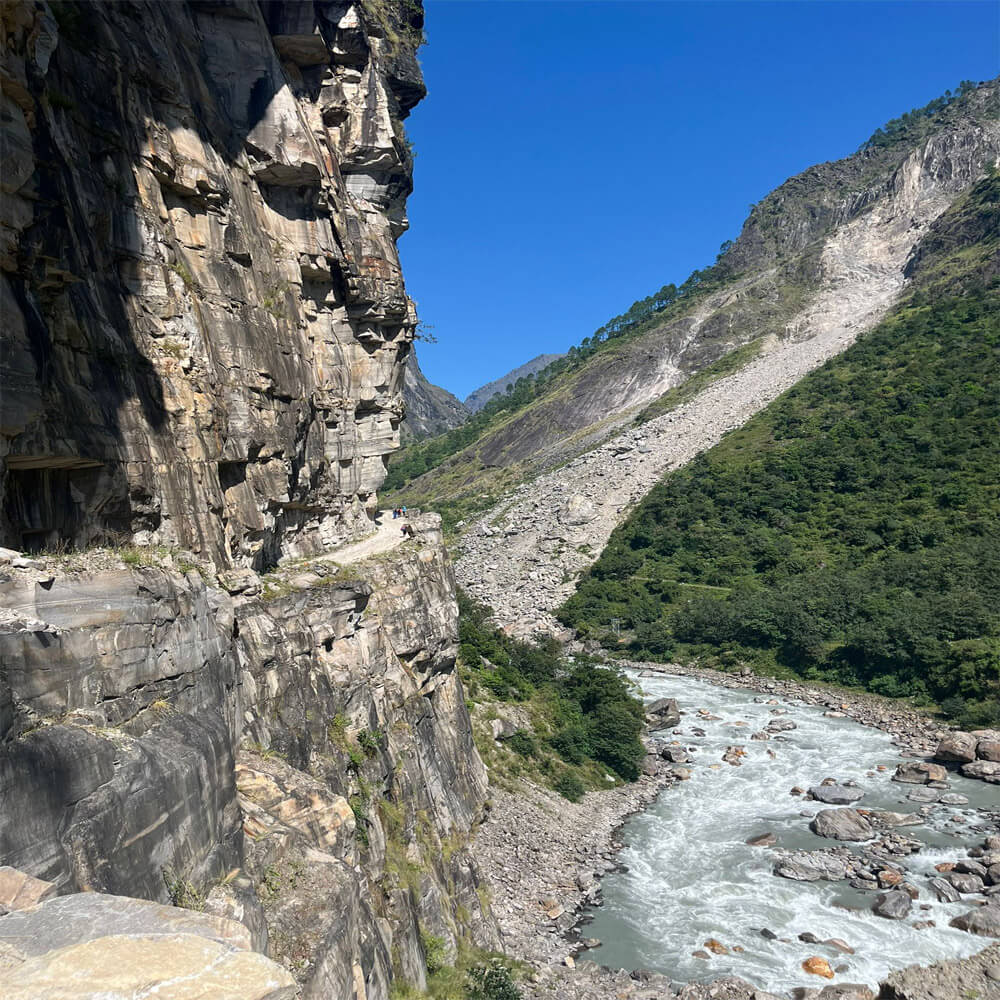
The golden guideline is to never climb when experiencing altitude sickness symptoms. It is time to drop to a lower elevation, even if it means shortening your walk, if you feel worse after a day of rest. Even a 300–500 m descent can provide immediate comfort.
Communicate honestly with your guide and fellow trekkers at all times. Early descent in the Himalayas is a show of prudence rather than weakness. The most important thing is your safety; the mountains will always exist.
Altitude sickness prevention
It is crucial to prepare before embarking on the Himalayan trekking routes. Knowing how to avoid AMS (Acute Mountain Sickness) begins long before you take your first step uphill. In addition to making your trip safer and more pleasurable, proper training, health examinations, and considerate behaviors can significantly lower your risk of altitude sickness.
Start with Physical Fitness
You must prepare your body for long days of walking at high elevations. At least two months prior to your expedition, start your training. Incorporate aerobic activities like swimming tour, cycling, running, or backpacking on nearby trails. Strength training improves your legs' and core's endurance, which is important for steep ascents. Your body's ability to withstand lower oxygen levels at high altitude increases with strength and conditioning.
How High Is “High Altitude”?
Altitude is one of the most crucial concepts to understand when trekking in the Himalayas since it affects how your body responds, how quickly you should ascend, and how you should prepare. The phrase "high altitude" may seem straightforward, but in the context of trekking, it refers to a scale that indicates how much thinner the air gets as you go higher into the mountains. Your body gets less oxygen the higher you travel, which is when altitude sickness might start to set in.
Generally speaking, altitude falls into three major categories:
- High Altitude Trek (2,400–3,500 meters): The majority of well-known Himalayan treks start here. With the right pace, most people can still adjust successfully to the thinner air. Treks include Langtang Valley and Ghorepani Poon Hill ascend to these altitudes. If you climb gently and drink plenty of water, you may experience mild dyspnea, particularly on steep ascents, although severe symptoms are uncommon.
- Very High Altitude Trek (3,500–5,500 meters): Trekkers should exercise the utmost caution in this range. The oxygen content falls to roughly 50–60% of its sea level value. This zone includes trekking destinations including Gokyo Lakes (5,357m), Annapurna Circuit (5,416m at Thorong La Pass), and Everest Base Camp (5,364m). Acclimatization days are crucial since they give your body time to adapt before increasing. If you relax and increase gradually, you can handle symptoms like a slight headache, exhaustion, and appetite loss.
- Extreme Altitude Trek (above 5,500 meters): Even the most fit trekkers find this level difficult. For extended visits, acclimatization alone may not be sufficient because the oxygen level is less than half of what your body is accustomed to. You fall under this group if you climb to Island Peak (6,189m), Lobuche Peak (6,119m), or Mera Peak (6,476m). For trekkers to manage these situations safely, they require training, experience, and direction.
You can make more informed plans if you are aware of these altitude zones. Moving at the proper rate to allow your body to adjust naturally is more important than rushing to the summit. The Himalayas serve as a constant reminder that safety and adventure go hand in hand. You may experience the wonders of the mountains without getting altitude sickness if you have the patience, awareness, and assistance of knowledgeable guides.
Altitude acclimatization in Nepal Trekking
Trekkers frequently make the mistake of entering high-altitude regions too quickly. Before going higher, spend a few days in locations like Kathmandu (1,400 m) or Lukla (2,860 m) to avoid AMS. To aid in your body's natural adjustment, spend an additional night in a mid-altitude town, such as Namche Bazaar or Manang, if your itinerary permits. Ascending gradually will allow your body to adjust to the reduced oxygen levels.
Consult a Doctor and Consider Preventive Medication
It is advisable to speak with a medical expert experienced in high-altitude travel prior to trekking. High altitude drug, that helps your body acclimate more quickly and reduces the risk of developing AMS. Drugs are a help, not a substitute for appropriate acclimatization. Keep that in mind. When it comes to dosage and timing, always heed professional advice.
Hydration and nutrition at high altitude
Remaining hydrated is one of the easiest yet most effective strategies to avoid altitude sickness. Because your body finds it difficult to adapt to altitude without adequate fluids, dehydration raises your risk of developing AMS. Steer clear of alcohol and tobacco, and drink three to four liters of water every day. Consume light but frequent carbohydrate-rich foods like pasta, rice, and potatoes. These foods are easier to digest at altitude and give you energy.
Mental Preparation and Awareness
Finally, keep in mind that mental preparedness is just as important as physical health. Respect your body's boundaries and have patience with it. No matter how young or fit, anyone can get altitude sickness. Acknowledge and treat early symptoms, such as headache, lightheadedness, and exhaustion. Trekking carefully, paying attention to your body, and never pushing yourself past your comfort level are the greatest ways to prevent AMS.
Safe Ascent and Acclimatization Practices
In the Himalayas, trekking requires patience and attentiveness in addition to strength and endurance. Knowing how your body adjusts to less air is one of the most crucial components of high altitude trekking safety. Acclimatization is the process that helps your body to adjust gradually to decreasing oxygen levels, and it’s the single best approach to prevent altitude sickness. Here's the proper way to accomplish things.
Climb High, Sleep Low
"Climb high, sleep low" is the golden rule of acclimatization tips for high altitude trekking. This implies that you should descend to a lower altitude to sleep, but you can trek to a greater level during the day. It allows your body to gradually adapt without stressing it. For example, your body can recuperate pleasantly if you sleep at 3,600–3,800 meters after trekking up to 4,000 meters during the day.
Ascend Gradually
Do not hurry across the mountains. After you reach 2,500 meters, you should limit your daily increase in sleeping altitude to no more than 300 to 500 meters for a safe ascent. Your body can adjust if you take a day off after every 1,000 meters of elevation gain. Although this gradual process may appear time-consuming, it is crucial for your general high altitude trekking safety and well-being.
Stay Hydrated and Eat Light
Drink plenty of water at least three to four liters a day because dehydration can exacerbate the symptoms of altitude. Caffeine and alcohol dry the body, so stay away from them.
Consume meals that are light but nutrient-dense, emphasizing warm, easily digested foods and carbs. Fruits, soups, and porridge are great ways to keep your energy levels up without putting undue strain on your stomach.
Plan Rest Days Wisely
Built-in acclimatization days are essential on well-traveled trekking routes such as the Annapurna Circuit and Everest Base Camp. While your body adjusts, you can explore the nearby highlands by staying an additional night in locations like Namche Bazaar or Manang. One of the best acclimatization tips for high altitude trekking is to take advantage of these rest days to stretch, drink water, and go on quick treks.
Listen to Your Body
The mountain determines your pace regardless of your level of experience. You should stop climbing right away if you get chronic headaches, nausea, or exhaustion. Hydrate, rest, and descend if symptoms increase. Making safety a top priority over pace guarantees a fun and successful Himalayan journey.
You can prevent altitude sickness and confidently take in the breathtaking views by according to these easy acclimatization procedures, which will guarantee your total safety while trekking at high altitudes.
Medication for altitude sickness
Even the best-prepared trekkers might experience the effects of thin air when climbing high in the Himalayas. It is crucial to comprehend how to treat altitude sickness using both natural and pharmaceutical means. These helpful techniques can make your trip safer and more comfortable, even though fitness and acclimatization are crucial.
Natural Remedies Used by Local Communities
People have traditionally used natural treatments to stay strong at high elevations in the villages of the Himalayas.
- Garlic soup or garlic cloves: Believed to thin the blood and improve oxygen flow.
- Ginger tea: Helps ease nausea and keeps the body warm.
- Honey and hot water: Provides quick energy and soothes the throat in cold weather.
- Butter tea (yak tea): A Tibetan favorite that provides calories and hydration.
These may not be a substitute for medical treatments, but they do support your body's natural and gentle correction process.
The Smart Approach: Balance and Consultation
Combining natural practices with modern medication is the best approach. Drink plenty of water, get enough sleep, go up gradually, and only take prescription medication when absolutely necessary. Prior to the walk, always get medical advice, and keep a small emergency medical kit with you. Balance is key in high-altitude trekking; you need to know when to trust your body, when to take medication, and when to descend for safety.
Trekking Preparation for High Altitude
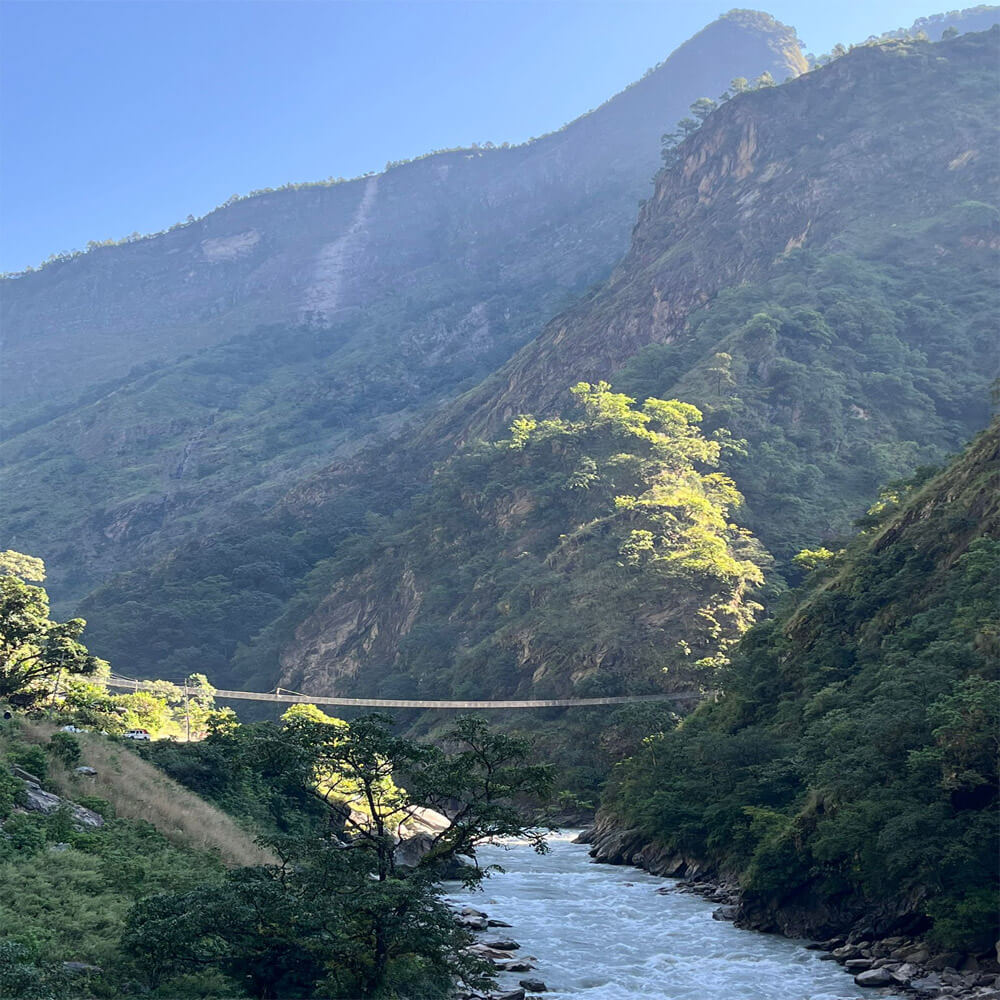
Enrolling in a guided or organized trek is one of the best decisions you can make when it comes to high-altitude trekking preparation. The Himalayas are stunning but challenging, and expert advice can be the difference between a perilous adventure and a safe, pleasurable trip. Here's why having knowledgeable assistance is so important when trekking at high altitudes.
Expert Knowledge and Local Experience
No one is more familiar with the terrain, the weather, and how the body responds to altitude than guides who have trekked in the Himalayas for years. They are able to recognize the early signs of altitude sickness much before you do. Their local knowledge aids in the planning of safe routes, the selection of appropriate acclimatization pauses, and the management of unforeseen difficulties like landslides or abrupt weather changes. One of the most crucial aspects of high-altitude trekking preparation is this degree of awareness.
Health Monitoring and Safety Equipment
Qualified trekking organizations supply first aid kits, oxygen oximeters, and occasionally even portable oxygen cylinders to their guides. They frequently check on the health of trekkers, particularly those who are over 3,000 meters. A qualified guide is aware of the proper course of action in the event that your oxygen saturation falls or you exhibit symptoms of AMS, which may include resting, descending, or requesting emergency evacuation. You stay secure under erratic alpine circumstances thanks to this planned attentiveness.
Emergency Response and Rescue Support
Organized treks have emergency rescue procedures in place, including helicopter evacuation, in case of severe altitude sickness. Guides work swiftly with nearby hospitals and emergency crews. Trekkers can relax knowing they have this safety net, letting them concentrate on the Himalayas' natural splendor rather than worrying about "what if" situations.
Cultural Connection and Mental Support
In addition to keeping you safe, a local guide introduces you to Nepal's customs, culture, and people. Their anecdotes and support frequently keep spirits up on difficult treks or when exhaustion sets in. Since a positive outlook makes it easier for your body to adjust to thin air and long days on the route, emotional strength is an underappreciated aspect of high altitude trekking preparation.
Gear for Trekking in High Altitude
Packing light and strategically while making sure you have everything you need is part of being ready for high-altitude trekking. Start by dressing in layers: a waterproof outer shell, an insulating fleece, and a moisture-wicking base layer. For chilly evenings, pack a down jacket, thermal gloves, and warm socks. During lengthy climbs and descents, trekking poles can help ease the strain on your knees. Sunglasses, sunscreen, lip balm, and a water bottle or hydration system shield you from the sun and wind. Remember to bring a headlamp, first aid kit, and an oxygen oximeter. A comfortable backpack and high-quality hiking boots round out your gear for high-altitude trekking.
Dealing with Altitude Sickness on the Trail
Understanding your body and paying attention to the mountains' speed are essential for both safety and success when walking high in the Himalayas. Even with enough planning, altitude sickness can strike without warning. The difference between a dangerous scenario and a fun adventure is knowing how to react and how to move carefully.
Recognize the Warning Signs Early
The initial effects of altitude sickness are not necessarily severe. Small, persistent symptoms such a slight headache, dyspnea, lightheadedness, or appetite loss are frequently the first signs. Many trekkers attempt to continue, thinking it is simply exhaustion. That is where errors start. It is best to pause, take a break, and talk to your guide or teammates if you have any of these symptoms. Ignoring these early indicators might result in more serious illnesses that can be fatal, such as brain swelling (HACE) or fluid in the lungs (HAPE).
Follow the Rule of Gradual Ascent in the Himalayas
The gradual ascent in the Himalayas is one of the most crucial safety guidelines. Once over 3,000 meters, you should gradually raise your sleeping altitude, ideally no more than 300 to 500 meters every day.Slowing down allows your body to adjust to decreased oxygen levels and thinner air. For this reason, rest days at locations like Namche Bazaar or Manang are a part of well-known trekking itineraries like the Annapurna Circuit or Everest Base Camp. These acclimatization intervals are essential times for your body to adapt; they are not only rest periods.
When to Rest and When to Descend
If your symptoms are minor, relax for the entire day, drink plenty of water, and abstain from smoking and drinking. You can resume your journey at a cautious speed if you feel better when you wake up.But if symptoms worsen, such nausea, disorientation, or extreme exhaustion, go right away. No summit or mountain vista is worth putting your health at danger for. Emergency evacuation stations and helicopter rescue services are available on the majority of Himalayan trails.
Stay Alert and Listen to Your Body
Even the toughest trekkers have to respect the rhythm of the mountains. Eat wholesome meals, stay hydrated, and take it leisurely when climbing. Recall that trekking in the Himalayas is a test of awareness and patience rather than a race. In addition to keeping you safe, a leisurely rise over the Himalayas will allow you to savor every second of your amazing adventure to the summit of the globe.
Health Tips for Himalayan Treks
Maintaining your health and safety should be your first concern when organizing Himalayan expedition. Although the mountains are breathtaking, even seasoned trekkers may find the altitude, cold, and lengthy walking distances difficult. To help you stay strong, active, and acclimated throughout your journey, here are some vital health guidelines for Himalayan treks.
Stay Hydrated and Eat Well
Drinking lots of water is one of the most basic yet crucial health advice. Your body may become dehydrated more quickly than you think due to the high altitude and dry mountain air. Make an effort to consume three to four liters of water every day. Steer clear of alcohol and excessive coffee since they might exacerbate dehydration. Consume meals that are light but nourishing and heavy in carbohydrates to help you stay energized at high elevations.
Pace Yourself and Rest Often
Trekkers frequently make the mistake of overexerting themselves. Take brief rests every hour and move gently, especially on steep climbs. In the Himalayas, endurance is more important than speed when trekking. You can significantly lower your risk of altitude sickness by adhering to the "climb high, sleep low" rule and taking rest days to acclimate.
Protect Yourself from the Weather
The weather in the Himalayas fluctuates rapidly. To adapt to temperature changes, always wear layers of clothing, such as fleece, windproof jackets, and thermal gear. To shield yourself from UV rays and snow glare, wear sunglasses, lip balm, and sunscreen. Keep your feet warm and dry to prevent blisters or frostbite.
Get Ready for Any Emergency
Keep a tiny first aid kit with you with basic medications for stomach problems, headaches, and nausea. Having travel insurance that includes high-altitude rescue coverage is also a good idea. You can walk with confidence, safety, and mental clarity to experience the genuine magic of the Himalayas by adhering to this health advice for trekkers.
High Altitude Trekking Tips FAQs
What is altitude sickness, and how common is it in the Himalayas?
Altitude sickness occurs when your body struggles to adjust to lower oxygen levels at high elevations. Even fit and experienced trekkers can experience symptoms above 3,000 meters, making it a common concern on routes like Everest Base Camp or Annapurna base camp
How can I prevent altitude sickness during my trek?
Ascend gradually, take acclimatization days, stay hydrated, avoid alcohol, and eat light, energy-rich meals. Following the rule “climb high, sleep low” is essential. Pre-trek physical training also helps your body cope with the altitude.
Are medications like Diamox necessary?
Diamox can aid acclimatization and reduce symptoms, but it should only be taken after consulting a doctor. Other medications, like Dexamethasone, are used for severe cases. Natural remedies like ginger tea or garlic soup can help mildly but don’t replace medical advice.
What should I do if I develop symptoms on the trail?
Stop ascending, rest, hydrate, and monitor your condition. If symptoms worsen severe headache, vomiting, or shortness of breath descend immediately. Portable oxygen and a Gamow bag can be lifesaving in emergencies.
Is trekking with a guide safer at high altitude?
Yes. Experienced guides recognize early signs of altitude sickness, manage acclimatization schedules, and provide immediate help if problems arise. Guided treks increase safety and confidence, ensuring you enjoy the Himalayan adventure responsibly.
Conclusion: High Altitude Trekking Tips
Though it requires knowledge, preparation, and respect, "high-altitude trekking in the Himalayas" is a dream for many. Despite being a serious worry, altitude sickness is manageable and frequently preventable with cautious preparation, progressive acclimatization, and attention to your body's cues. Never disregard early warning signs, pace yourself, eat healthily, and stay hydrated. While appropriate equipment and travel insurance provide additional security, trekking with knowledgeable guides guarantees both safety and comfort of mind.
In the end, there is no greater pleasure than high-altitude trekking: stunning mountain views, cross-cultural interactions, and a feeling of accomplishment. Your trip in the Himalayas may be memorable and safe with the help of our company, Nepal Trekking Routes.






